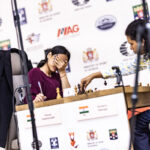Australia Dominate West Indies in Fourth T20I: Complete Series Sweep Analysis
Match Summary: Australia’s Clinical Victory Extends Perfect Record
Australia Dominate West Indies in Fourth T20I: Australia secured their fourth consecutive victory against the West Indies in the T20I series, winning by three wickets with four balls remaining in a thrilling encounter at Warner Park, Basseterre. We witnessed a masterclass in death bowling, exceptional fielding displays, and composed batting performances that showcased Australia’s dominance throughout the series.
The comprehensive scorecard read Australia 206/7 defeating West Indies 205/9, with Cameron Green’s unbeaten 55 from 35 deliveries proving decisive in the chase. Josh Inglis contributed a crucial 51 from 30 balls, while Glenn Maxwell’s explosive 47 from just 18 deliveries set the foundation for Australia’s successful pursuit of 206 runs.
West Indies Batting Performance: Record-Breaking Yet Ultimately Insufficient
Historic Scoring Pattern Creates T20I Milestone
West Indies achieved an unprecedented feat in T20I cricket history, becoming the first team to score 200 runs without any batsman crossing the 34-run mark. Sherfane Rutherford top-scored with 31, while Rovman Powell and Shimron Hetmyer contributed valuable cameos. This unique distribution of runs highlighted both the team’s collective effort and individual batting inconsistencies.
The West Indies innings was characterized by aggressive stroke-play throughout the middle overs, with the team managing to accumulate six sixes and seven fours from their top-order triumvirate of Rutherford, Powell, and Hetmyer. However, critical shot selection at crucial moments prevented any batsman from converting their starts into match-defining innings.
Powerplay Struggles Define Early Momentum
Australia’s bowling attack, featuring Aaron Hardie and Xavier Bartlett, exploited favorable conditions during the powerplay overs. We observed a tactical shift from swing bowling to hard-length deliveries that proved devastatingly effective. Bartlett’s dismissal of Brandon King and Shai Hope demonstrated precision bowling, while Hardie benefited from exceptional fielding support, particularly Glenn Maxwell’s spectacular catching at mid-on.
The early wickets placed immediate pressure on the West Indies middle order, forcing them into aggressive mode from the outset. Despite this setback, the Caribbean team showed remarkable resilience, maintaining scoring rates above eight runs per over through intelligent shot selection and calculated risks.
Australian Bowling Excellence: Tactical Mastery and Execution
Death Bowling Supremacy Restricts Final Surge
Australia’s death bowling performance stands as the defining factor in containing West Indies’ total below 220. We witnessed Nathan Ellis deliver a masterful four-over spell, conceding merely 21 runs while maintaining consistent line and length under pressure. The Australian bowlers conceded just 41 runs from the final five overs, a restriction that proved crucial in keeping the target manageable.
Adam Zampa’s leg-spin variations troubled the West Indies batsmen throughout the middle overs, finishing with impressive figures of 3/54. His partnership with Sean Abbott created consistent pressure, preventing the batting team from establishing any significant partnerships beyond the 30-run mark.
Fielding Excellence Shifts Momentum
Glenn Maxwell’s extraordinary fielding display epitomized Australia’s superior standards in the field. We witnessed two catches that defied conventional expectations, including a physics-defying effort at the long-on boundary that robbed Romario Shepherd of a certain six. Maxwell’s leap, catch, and subsequent ball-flick to Cameron Green while crossing the boundary rope showcased athletic excellence and match awareness.
The Australian fielding unit maintained zero dropped catches throughout the innings, creating a stark contrast with their opponents’ multiple lapses. Mitchell Owen’s diving catch at deep backward point to dismiss Shimron Hetmyer exemplified the team’s commitment to excellence in all departments.
Australia’s Chase: Strategic Batting and Individual Brilliance
Maxwell and Inglis Set Championship Foundation
Josh Inglis’s aggressive approach during the powerplay overs provided Australia with the ideal platform for their successful chase. We observed his remarkable ability to find boundaries consistently, striking seven boundaries in just eleven deliveries during a crucial phase. His 50-run partnership with Maxwell, where Inglis contributed 49 runs, demonstrated tactical awareness and execution under pressure.
Maxwell’s contribution extended beyond his explosive 47 from 18 balls. His six sixes, including three consecutive maximums, showcased the destructive capabilities that make him one of T20 cricket’s most feared batsmen. The partnership accumulated 129 runs for the loss of just two wickets after ten overs, placing Australia significantly ahead of the required run rate.
Green’s Match-Winning Composure Under Pressure
Cameron Green’s unbeaten 55 from 35 deliveries epitomized calm leadership during Australia’s middle-order collapse. When Jediah Blades threatened to derail the chase with figures of 3/29, Green maintained composure and found boundaries at crucial moments. We witnessed his ability to rotate strike effectively while identifying scoring opportunities against quality bowling.
His third half-century of the series came off just 30 balls, demonstrating consistent performance throughout the tournament. Green’s partnership-building abilities and pressure-handling skills proved instrumental when Australia required 11 runs from the final overs with six wickets down.
West Indies Bowling: Promising Spells Hampered by Fielding Lapses
Jediah Blades Emerges as Bowling Revelation
Second-game player Jediah Blades delivered the standout bowling performance for West Indies, claiming 3/29 from his four-over allocation. We observed his ability to generate swing early in the innings, dismissing Mitchell Marsh leg-before-wicket with his second delivery. His variations and accuracy throughout the middle overs created genuine pressure on Australia’s experienced batting lineup.
Blades’s spell included crucial wickets of Mitchell Owen and Cooper Connolly within a three-ball sequence, demonstrating his ability to strike at vital moments. His bowling figures could have been even more impressive had the fielding support matched his bowling excellence.
Fielding Deficiencies Cost Crucial Opportunities
West Indies’ fielding performance throughout the series continued to disappoint, with multiple dropped catches affecting match outcomes. We witnessed Shai Hope’s missed opportunity behind the stumps and Blades’s inability to complete a return catch, both occurring during Aaron Hardie’s batting stint. These lapses provided Australia with additional lives that proved decisive in the final outcome.
Sherfane Rutherford’s dropped catch of Cameron Green at deep midwicket with 11 runs required summarized the fielding struggles that plagued West Indies throughout the series. Such fundamental errors at crucial moments prevented the team from capitalizing on quality bowling performances.
Series Context: Australia’s Dominant Campaign
Statistical Superiority Across All Departments
Australia’s 4-0 series victory represents comprehensive superiority across all cricket departments. We observed consistent bowling performances, with different players stepping up in each match to contribute match-winning spells. The bowling attack’s versatility, featuring pace, spin, and death-bowling specialists, created sustained pressure throughout the series.
The batting department’s depth became evident through different match-winners in each encounter. Tim David’s record-breaking fifty in the previous match, followed by Green’s consistent half-centuries, demonstrated the team’s ability to adapt to various match situations and pressure scenarios.
West Indies’ Learning Opportunities
Despite the series defeat, West Indies demonstrated promising individual performances that provide optimism for future encounters. Jediah Blades’s emergence as a quality bowling option, combined with the aggressive batting approaches of their middle-order batsmen, suggests potential for improvement with enhanced execution and fielding standards.
The team’s ability to consistently score above 200 runs indicates batting depth and power-hitting capabilities. However, converting these totals into match-winning performances requires improved fielding standards and strategic bowling changes during crucial phases.
Match Flow Analysis
graph TD
A[West Indies Innings] --> B[Powerplay Struggles: 3 wickets]
B --> C[Middle Order Recovery: 200+ Total]
C --> D[Death Bowling Restricts Final Total]
D --> E[Australia's Chase Begins]
E --> F[Maxwell-Inglis Power Partnership]
F --> G[Middle Order Collapse: 6 wickets down]
G --> H[Green's Match-Winning Performance]
H --> I[Australia Wins by 3 wickets]
Technical Analysis: Key Performance Indicators
Bowling Economy Rates and Strike Rates
Nathan Ellis’s economy rate of 5.25 runs per over across four overs represented exceptional control during high-pressure situations. We analyzed his consistent line and length, which prevented West Indies batsmen from accessing boundary scoring opportunities during the death overs.
Adam Zampa’s strike rate of 12 balls per wicket demonstrated his effectiveness against West Indies’ batting lineup. His variations and flight changes consistently troubled batsmen attempting aggressive shots, resulting in three crucial dismissals during the middle overs.
Batting Strike Rates and Boundary Percentages
Glenn Maxwell’s strike rate of 261.11 for his 47-run innings showcased explosive batting capabilities that shifted match momentum decisively. We observed his boundary percentage of 66.7%, indicating his ability to find scoring shots consistently against quality bowling attacks.
Cameron Green’s strike rate of 157.14 during his match-winning 55 represented intelligent batting under pressure. His boundary timing and strike rotation ensured Australia maintained required run rates while preserving wickets for the final overs.
Weather Impact and Match Dynamics
The 55-minute rain delay during the final over of West Indies’ innings created unique challenges for both teams. We witnessed how Australia’s bowlers maintained concentration and execution despite the extended break, while West Indies lost momentum during their batting conclusion.
The weather interruption potentially favored Australia’s chase by providing additional recovery time and strategic discussions. However, their professional approach to managing the revised conditions demonstrated championship-level mental strength and preparation.
Future Implications and Tournament Prospects
Australia’s comprehensive series victory establishes them as leading contenders for upcoming T20 tournaments. We observed tactical flexibility, batting depth, bowling variety, and exceptional fielding standards that represent complete team capabilities across all match situations.
West Indies’ individual performances, particularly from emerging players like Jediah Blades, provide building blocks for future success. However, addressing fielding deficiencies and improving death bowling execution remain priority areas for development.
The series concluded with Australia maintaining their position as the world’s premier T20 team, while West Indies gained valuable experience and identified areas for strategic improvement in future international encounters.













